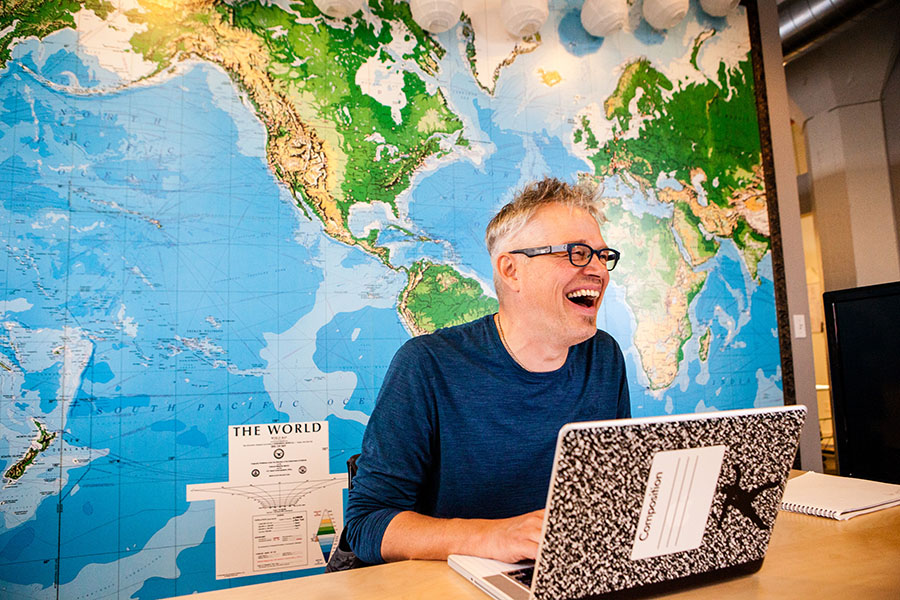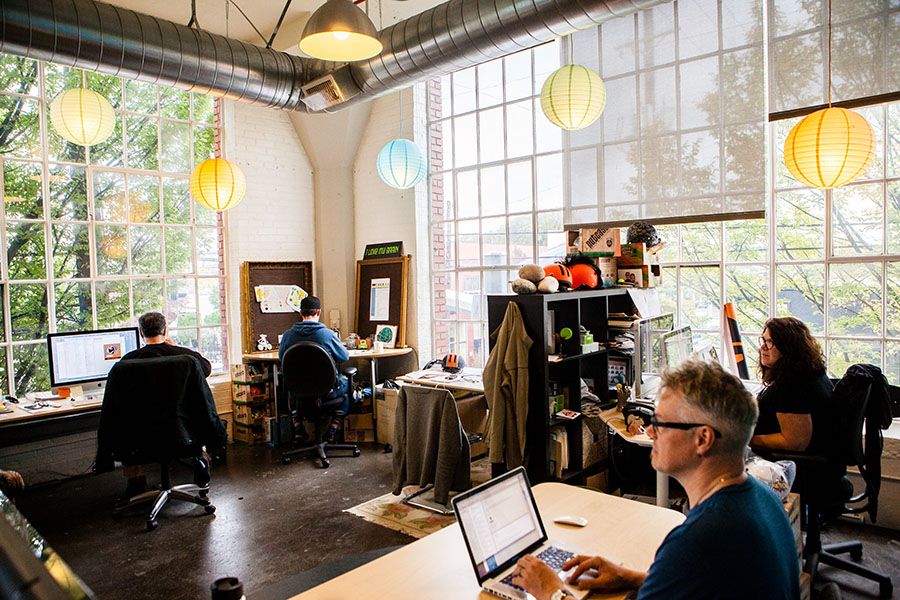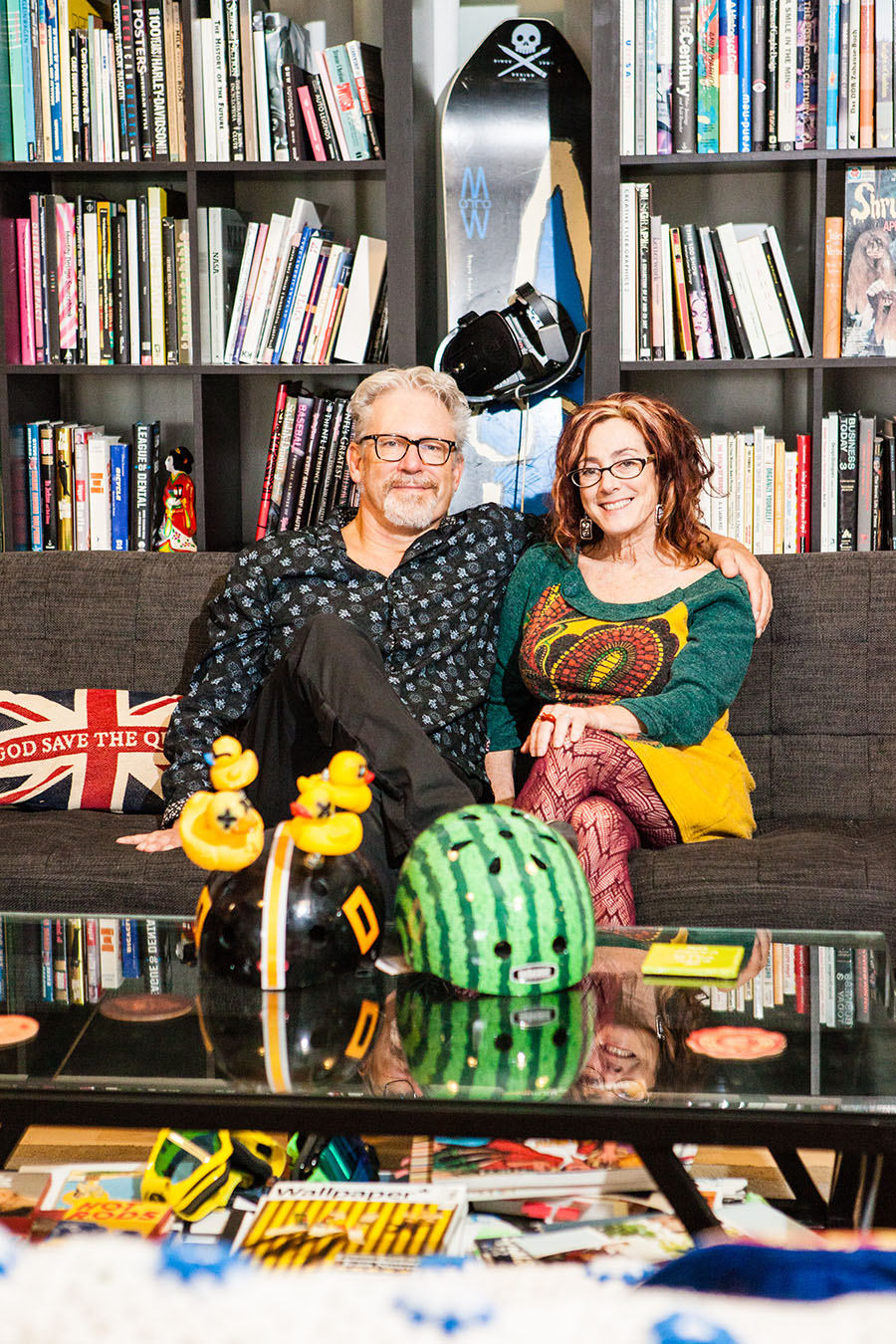Shaping a homegrown helmet startup into a global safety brand, one Nutcase at a time
Mr. and Mrs. Nutcase: Michael Morrow and Miriam Berman, with the original D.I.Y. creation and the iconic Nutcase Watermelon helmet.
So you don’t care for your bike helmet — it’s clunky, it’s dorky and you’re far happier riding around bareheaded?
Nutcase Helmets co-founders Michael Morrow and Miriam Berman would like a word.
The husband-and-wife pair is shaking things up with a growing line of playful, brightly hued brain buckets that turn the conundrum of tragically unhip headgear on its ear. Why not ditch the dated, cookie-cutter designs, the thinking goes, and crown the people’s noggins with juicy green melons, glossy black eight-balls, and any other eye-popping art you can wrestle onto a spherical plane?
This brave quest to personalize the humble helmet began way back at the turn of the millennium, in Morrow and Berman’s garage, with a few monster metal screws and four unfortunate rubber duckies.
Morrow was headed to the Oregon State University Beavers versus University of Oregon Ducks Civil War football game and wanted to creatively display his Beaver spirit. So he found an old black helmet, decked it in orange-and-white tape, and adorned the crown with a flock of rubber duckies impaled atop metal spikes.
The homegrown headgear was a hit, and Morrow, a longtime sports-design guy with roots at Nike, felt his entrepreneurial senses tingle.
He shared his vision with Berman, also a creative thinker, and together the two eyeballed the existing helmet market, noticing the same designs — male-oriented, exoskeleton-like, aggressively sporty — repeated ad infinitum.
So they created an off-the-wall prototype: a watermelon helmet with seed-shaped air vents and a streamlined silhouette, more hat than helmet.
“That beautiful round canvas for art is what we originally saw,” recalls Morrow. “When you mix that with graphic design or pattern, a helmet becomes more like a baseball cap.”

A wall of helmets greets visitors at the Nutcase headquarters in Portland.
They made a website, devised additional designs and began filling orders right from the garage. It was a creative whim, really, just for fun, but then an email arrived from a family whose son had survived a serious bicycle accident. Doctors believed his beloved Nutcase helmet had saved him.
This was the first of many love letters the company would receive from grateful self-identified “Nutcases” who’d escaped serious injury. Morrow and Berman, parents themselves, realized their venture was about more than simple self-expression.
“That’s what put it into crystal view for us,” says Berman. “This has an altruistic mission as well as being a fun, creative adventure.”
These helmets have struck a surprisingly emotional chord with wearers, agrees Nutcase brand connector Philip Mascher: “If you put on a helmet that looks like a watermelon, you’re going to get a lot of reaction, you’re going to put smiles on people’s faces. For most people, pretty quickly, the helmet becomes part of their active persona. Our customers often turn into incredible brand ambassadors.”

Philip Mascher, brand connector at Nutcase Helmets
Morrow and Berman have built a global brand around that marriage of safety and personality, producing bike, skate, water, snow and motorcycle helmets wrapped in everything from Mexican sugar skulls to fluttering cherry blossoms, with “I love my brain” emblazoned onto each.
Collaborative partnerships have also helped Nutcase to cross-pollinate its gospel of fierce individuality.
Every spring, Nutcase teams up with the Brain Injury Association of America to promote Brain Injury Awareness Month, and the partnership has breathed new life into a longstanding campaign, says BIAA President and CEO Susan H. Connors: “I love that Nutcase comes at protecting your brain with an ‘express your personality’ message. They’ve really put a different twist on safety.”
Every fall Nutcase puts out a call for helmet-design submissions and chooses three artists to collaborate with on production-line helmets. The artists also have a chance to attend two of the largest global bike shows — Germany’s Eurobike and Las Vegas’ Interbike — to showcase their designs and create murals live. The murals are then auctioned off, with proceeds supporting World Bicycle Relief, which distributes specialty bikes to students, health care workers and entrepreneurs in developing countries.
Partnering with Nutcase has definitely expanded awareness of WBR’s mission, says development director Katie Bolling: “We’ve been able to reach a new audience to share the message of our organization with. We have a lot of support from the cycling community, and Nutcase has allowed us to introduce our organization to non-spandex -clad cyclists.”

The Nutcase office in the Ford Building encourages creativity and collaboration.
Meanwhile, helmet use is on the uptick worldwide, with the Nutcase star rising in tandem. Morrow and Berman, who now oversee a staff of 16, outgrew their family garage long ago, but that old rubber ducky helmet still holds its pride of place in the Nutcase offices.
It’s a talisman signaling how far they’ve come, Morrow says, but also a reminder that you’re never finished innovating: “We haven’t gotten there yet. We’re two-thirds of the way to becoming a 15-year overnight success.”
Shifting conceptions of style and safety are perpetually tough nuts to crack, admits Mascher, but helping customers connect emotionally to a product seems to be key: “People want to surround themselves with things that have meaning. Functionality is so easy to come by these days. What’s just as important is, ‘What does this say about me as a person?’”


